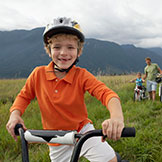
By: Andy Feld, MPT, CSCS, CMTPT
As we all know, boys between ages 9 to 15 grow like weeds. We notice that they need more sleep and want to eat constantly.
One problem with all of that growth is that oftentimes their bones grow at a faster rate than their muscles. This discrepancy puts them at risk for certain types of injuries. Sever’s Disease and Osgood-Schlatter Disease are two good examples of growing pains in legs. These conditions are not as scary as they sound. In both cases, extra tension placed on growing bones in the heel (Sever’s) or top of the shin just below the knee (Osgood-Schlatter), combined with high or recent change in activity can result in irritation to the bone where the muscles attach.
Symptoms and Treatment
Symptoms include localized pain during and following activity. At times, swelling can be present as well. These conditions tend to be more prevalent in boys versus girls.
The best, but often most difficult treatment, is rest. It is important that young athletes not continue to push through pain. Icing for about 10 minutes following activity can be helpful in reducing post-activity irritation. Using an over-the-counter heel cushion in their shoes during competition can be helpful. Having your athlete on a stretching program can help reduce the risk of problems developing. Stretching should always be done gently, held for at least 30 seconds, and completed when the body is warm (see attached handout for examples).
More Information
If symptoms persist or worsen, consulting with a physical therapist, athletic trainer, pediatrician, podiatrist, or orthopedist is a good idea. Signs that it is time to consult a professional would include pain at rest, pain intense enough to bring about tears, symptoms persisting greater than a few weeks or any redness present at the injury site.
If your son is suffering from Sever’s Disease or Osgood-Schlatter Disease, turn to the experts at Midwest Orthopedic Specialty Hospital.